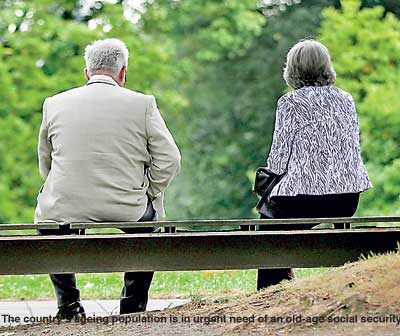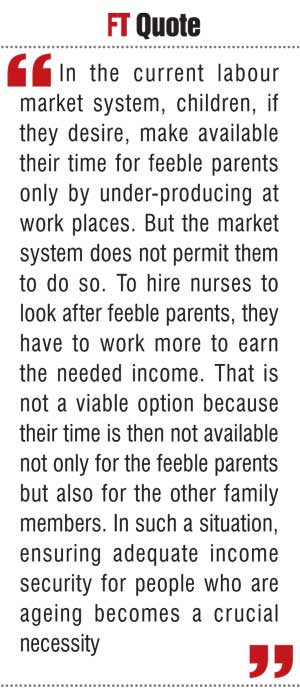Wednesday Jan 07, 2026
Wednesday Jan 07, 2026
Monday, 30 November 2015 00:00 - - {{hitsCtrl.values.hits}}
 Providing old-age social security is a national issue
Providing old-age social security is a national issue
Sri Lanka’s population is ageing and an ageing population needs a viable old-age social security system. In this regard, the Economic Policy Statement or EPS of the Government has pledged to establish a “national pension plan taking into account the retirement needs of the workers”.
The reference here is only to the workers but what is needed is a national pension plan for the whole population consisting of the employed, the self-employed and the never-employed. Narrowing this national objective further, the Budget 2016 has sought to tackle the problem of only one segment of the working population, namely those in the government sector. In view of the ever-rising and unaffordable cost of paying pensions to public servants, it has proposed to establish a contributory pension scheme for the new recruits to the public service.
IPS coming up with a research report on pension reforms
What is therefore needed is a comprehensive social security policy covering the whole population of the country. In this connection, the Government can draw on a report prepared by two researchers – Shanika Samarakoon and Nisha Arunatilake – attached to the Institute of Policy Studies or IPS. The report titled ‘Extending Adequate Pensions for all in Sri Lanka – Where are the Gaps?’ was presented to a national consultation on social security sponsored by UNESCAP in Colombo recently.
Existing schemes are mostly dependent on public funds
The report has taken into account projected demographic changes in Sri Lanka in the next 40 years or so and prognosticated on the desirable system of social security which the country should have considering the present system of income security available to the population.
The authors have documented 16 such schemes established from time to time dating back to 1901 when the public servants’ pension scheme was introduced.
However, there has not been any attempt at introducing a national level social security system since all these 16 schemes have sought to address the social security issues of selected groups of individuals. Most of these schemes are not self-supporting and are therefore dependent on government funds for paying out benefits.
A previous attempt at pension reforms
A national consultation on pension reforms similar to the one held recently in Colombo was held in 2001 under the aegis of the World Bank. At that consultation, all the stakeholders, those from the private sector, public sector and donors were assembled. The consultation led to the appointment of a steering committee on pension reforms of which this writer functioned as the Chairman. The committee designed a comprehensive pension reform program aimed at improving the efficiency of the Pensions Department, setting up a social security board by amalgamating both EPF and ETF and introducing a pension system for the self-employed and informal sector workers through the insurance industry.
However, the work got halted with the election of a new Government in 2004 which did not believe in the necessity for pension reforms.
What is needed is social security and not income security
The report by Samarakoon and Arunatilake has highlighted the need for income security. However, in the view of this writer, income security is a narrow concept. A much broader one would be to look at the social security of the ageing population.
Income security assumes that if one has money income, one can afford to have everything he desires once he becomes old and feeble. It then presupposes that there is a market system that would keep supplying all his requirements at the old age.
Social security, on the other hand, looks at social protection of old people at every stage. That protection encompasses social networks that would care, love and take control of old people who are otherwise unable to attend to their own requirements. In a traditional culture, this is done by the family and kinship system in society. In such a system, there is a two-way family relationship that is built to help each other. The old people look after the offspring of their offspring till such time as they are physically capable of doing so. Once they become feeble, their own offspring or the offspring of their offspring would look after them. All their needs – foods, shelter, clothing, healthcare and spiritual enlightenment – are provided through the family support system. This is a sustainable system with no guilty feeling on either side. Each side helps each other through a social bond which is inviolable in terms of the ethos and norms of society.
Women’s entry into the labour force has dented the traditional social security system
However, this system has partly broken down mainly due to the entry of female offspring into the labour force. I say partly because one side of the social bond still operates. That is, old-aged parents still support their offspring to bring up their grandchildren. This is an important contribution made by them in a background where services of caring and protective housemaids have become increasingly expensive or non-available. 
Thus, female workers have been able to contribute to the national economy by supplying their labour due to the in-house production of maids’ services by parents. However, when parents become feeble and are no longer able to make a positive contribution to the family unit, looking after them becomes an extremely difficult task for children who had once got their free services to bring up their children. They are being constrained by lack of adequate time as well as lack of adequate income.
In the current labour market system, children, if they desire, make available their time for feeble parents only by under-producing at work places. But the market system does not permit them to do so. To hire nurses to look after feeble parents, they have to work more to earn the needed income. That is not a viable option because their time is then not available not only for the feeble parents but also for the other family members. In such a situation, ensuring adequate income security for people who are ageing becomes a crucial necessity.
Issues in developing a viable social security system
There are three issues in developing such a system. One is who would bear the cost. Another is how it could be made sustainable and viable. The third is how it could be managed with least cost to society and those who fund it.
Best social security is for the young to save for the future
In any society, the viable and sustainable method of ensuring social security is to get the people to save enough for the old age. This is consistent with the life cycle income theory in which the income over time is posited to move in the fashion of an upturned U curve. This is due to the higher productivity in the young age and lower productivity in the old age.
However, the consumption grows steadily over time generating a surplus when the productivity is high and a deficit when the productivity slows down. Hence, the challenge for the market system is to collect the surplus into a long-term investment so that it would be available for use when the person reaches the old age. There are some pockets of people in society who would resort to this tactic to safeguard their own old age. But, that is rare though it presents an exclusive system of old age income security. What is needed is an inclusive saving system so that all those in the young age would save for their old age. But the challenge is how to incentivise the young people to get into long-term saving and investment.
Generation Y is pro-consumption and averse to savings
This was not a problem in traditional societies where savings were valued as a social habit. To some extent, this is true even today for the Chinese and the Japanese who are reported to be notorious savers.
However, in Sri Lanka, there are two developments, one longstanding and the other emerging, which would impede society’s desire to make long-term savings for old age. The longstanding one is the obviation of the necessity for making savings for the old age because the Government was supposed to meet that once a person becomes old. Further, the universal supply of education and healthcare through community funding too made it unnecessary for a person to save for himself or the other family members. The emerging one is the oncoming of the generation called Generation Y which is pro-consumption even at the expense of others. They expect parents and governments to meet all their current as well as future requirements. Hence, to build up systems where individuals would save for themselves have become a challenging issue.
Governments have punished savers through low interest rate policies
Governments’ interest rate policies too have impeded the long-term savings habits of people. All governments in Sri Lanka since independence, except in 1954 and 1955, have been running state affairs with deficit budgets.
To cut the interest costs to the Government when they borrow money from the market, interest rates were kept deliberately at a low level. If there was pressure for the interest rates to go up due to perceived high inflation expectations, the rates were moderated by meeting the governments’ financing requirements through the central bank.
The result was self-defeating since it further augmented the inflation expectations and dried up even the available savings flows. Hence, governments had to get the central bank to print more and more money in order to supply itself with needed funds and it exacerbated the prevailing inflationary-savings situations. This is where Sri Lanka is today and it has forced the government to introduce various types of pension schemes targeting both the formal and informal sector workers, fully or to large extent, funded by the taxpayers or employers.
The Samarakoon-Aruntilake Report has identified 16 of such schemes prevailing in the country and 12 of them have been introduced since independence. Out of them, six schemes have been introduced during the last 10-year period. But, all these schemes, except EPF and ETF, have not been self-supporting and the Government had to heavily subsidise them to keep them floating.
Viability comes from the free funding of social security systems
This gives rise to the second issue, namely, the sustainability of the pension schemes in operation. If pension funds are to be supplied by persons other than those direct beneficiaries, there is always incentive for them, no matter whether it is the Government or the private sector, to avoid the responsibility. Governments do not allocate adequate money in time to make the pension schemes viable.
A good example is the unfunded public servants pension scheme which is being funded by current and future taxpayers through a ‘Pay-As-You-Go’ system. Estimates by various analysts have put the unfunded gap in the pension scheme between Rs. 1,000 to 1,500 billion. If the Government decides to fund it in one go, it would amount to about 7-10% of current GDP. Obviously, the current financial position of the Government does not allow it to do so. In the case of both EPF and ETF, the scheme has acted as a tax levied on the private sector. Hence, in the absence of an effective supervisory system, private sector enterprises are forced to evade the payments through devious methods. The final result is the non-accumulation of a sufficient amount of funds in the system to gain capability of meeting social security requirements upon retirement.
This is evident when one examines the size distribution of the funds at EPF. There, about 80% of the accounts are with a balance of Rs. 50,000 or less.
Cut running expenditure through digitisation
The management of pension schemes to provide an efficient service to beneficiaries is the third issue. In schemes which basically depend on manual methods, the costs have become enormously high on one hand and service efficiency low on the other.
Hence, digital systems in which the whole range of operation of the system has to be computerised have become the necessity of the day. The proposed national digital identity or NDI will help the management of the pension schemes by providing a unique number for the beneficiaries. Hence, the acquisition of software to run pension schemes at the national level is not a serious issue since there are already systems available off the self. All that is needed is to acquire one and customise it.
There will be teething problems in view of the need for training officers to operate, upgrade and maintain the systems. However, such problems are time-limited and would disappear over the time. With 16 schemes in operation in Sri Lanka today, there is duplication of the work. It is necessary to amalgamate all these schemes into a general social security board that would operate on high technology to cut the management costs and provide an efficient service.
Social security for all needs a superannuation tax
The Samarakoon-Arunatilake Report has considered the possibility of introducing a universal pension scheme in Sri Lanka covering those employed in the formal public and private sectors as well as those in the informal sectors.
If it is fully funded by the State, which in my view is not a good option, it would cost the Government annually some 1 to 3% of GDP at present and between 3 to 5% of GDP by 2050 depending on the threshold age of the pension beneficiaries. Such a system is both socially and politically appealing but fiscally disastrous since it would create another hidden monster to feed on the public finances of the country in the years to come.
One solution for the Government to overcome it is to have a special superannuation tax levied on individuals and accumulate the funds into a special national pension fund as is being done in other countries.
Appoint a steering committee without delay
Old-aged social security is a burning issue in Sri Lanka. Time is running out for the Government to tackle this issue. Hence, the Government should, as a priority, kick-start the work by setting up a high powered steering committee to come up with a viable and sustainable social security system for the country.
(W.A. Wijewardena, a former Deputy Governor of the Central Bank of Sri Lanka, can be reached at [email protected])